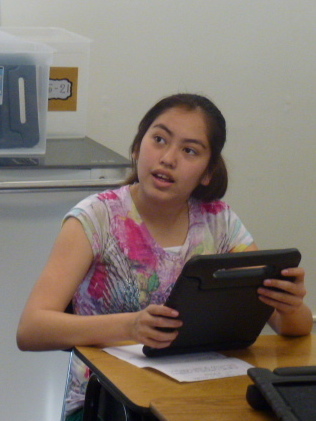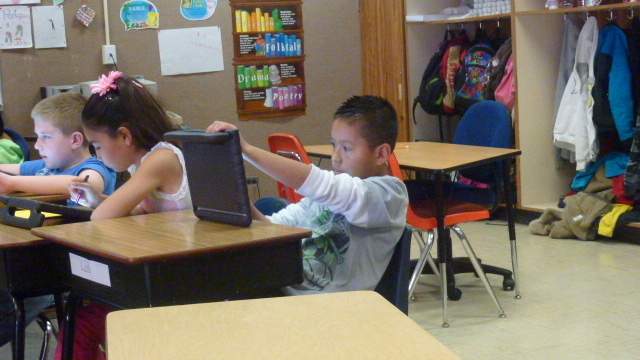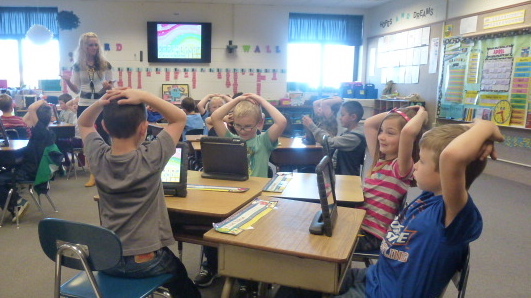
Students in Ashley Johnson’s fifth-grade class have been using individually issued iPads to produce video papers on matter, volcanoes and the pros and cons of school uniforms.
But when these fifth-graders leave Paul Elementary School for West Minico Middle School in the fall, they will go to a school with fewer devices than students. “I’m excited for next year, but I’m kind of going to miss my iPad,” fifth-grader Liberty Schaeffer says.
Paul Elementary may face an iPad predicament of its own next fall. Five months after receiving the one-to-one devices, financed through a one-year grant, the program is in jeopardy.
The classroom experience
If you tour Paul Elementary — as many Idaho teachers and administrators already have done this year — you’ll see iPads fully integrated into the classroom experience. In Angela Bovee’s kindergarten class, the commotion of class activity is punctuated by the music and voices of applications that teach spelling and phonics. In Johnson’s class, students eagerly show off video reports and praise their favorite apps.
None of the apps are games. The kids just think they’re games, principal Colleen Johnson said.
Some common themes emerge:
- The iPads are used to help students learn at their own pace, in their own way. First-graders in Tiffany Galloway’s class can choose a number-line app or a “butterfly” app that allows them to drag butterflies into animated nets; the apps drill the same addition and subtraction skills. In fifth grade, advanced students can continue working on videos, incorporating more information into projects, rather than have to wait on classmates.
- The iPads are used to encourage collaboration. When Galloway’s first-graders finish illustrating a story they’ve read, their drawings can be displayed on a high-definition screen. Carolyn Monson’s third-graders use iPads and the HD screen to showtheir work, as the class goes over approaches to solving math word problems.The fifth-grade sc

Paul third-graders Michael Schuch, Kaitlyn Banda and Luis Valiente use their school-issued iPads to work on math word problems. hool uniform videos were done in groups of four.
- The iPads do not supplant traditional skills. First-graders still hand-write a “sloppy copy” of a story, Galloway says, before typing an electronic version. Some of Ashley Johnson’s fifth-graders do better on paper spelling tests, so they have that option.
Gauging the change
In politics, a lot can happen in five months. In November — a few weeks before the iPads were deployed in Paul — Idaho voters rejected Proposition 3, which would have equipped all high schoolers with laptops. In response, the 2013 Legislature agreed to keep the technology effort moving with $3 million in pilot grants, money that might support Paul’s program.
In education, five months isn’t much time to grade the effectiveness of major change. Paul educators are enthusiastic about the iPad program, but that enthusiasm is based on anecdotal evidence.
They’ve seen signs of a cultural change, in and out of the classroom.
Colleen Johnson talks about the fourth-graders who, on their own and for no class credit, decided to use their iPads to produce an anti-bullying video for second-graders.
In a school where 43 percent of the students are Hispanic — where the school message board promotes upcoming parent-teacher conferences and a book fair, one side in English, one side in Spanish — the iPads are viewed as a cultural bridge. Ashley Johnson talks about the mother of a student who had to ask, through her child, to have a look at an iPad, since she’d never seen one.
What the school hasn’t seen, yet, is hard evidence of student growth. Some answers may come after April 22, when students take the Idaho Standards Achievement Test.
In the meantime, the staff talks — again, anecdotally — about students who are more excited about their education.
“They want to tell the teacher and demonstrate to their teacher what they can do,” Colleen Johnson says.

Galloway, in her second year teaching first-graders, has seen the difference as well. “They are just so excited. They can be more creative.”
Josi Christensen, the mother of a third-grader and first-grader at Paul Elementary, senses the excitement as well — but worries about kids being overstimulated. She’s upset that her children are being used as “lab rats” for an unproven initiative to privatize public education. But, she freely admits, those concerns are not shared by her children. “They love it. They think it’s great.”
The funding question
When members of the state’s education reform task force came to Twin Falls last week, Christensen showed up to urge the state not to fund Paul’s iPad pilot program.
For 2013-14, funding is the $244,000 question surrounding the program. It is unclear if, or how, the program will be funded next year.
A one-year grant from Park City-Utah based iSchool Campus covered the first year of three-year leases of Apple equipment, and the first year of three years of technical support and professional development, furnished by iSchool. (This support has proven to be critical; “I was naïve in believing all you needed was iPads and you just go,” says Colleen Johnson.)
The Minidoka County Joint School District was forthright about its financial situation, though. “We do not have the general fund to sustain (this program), and that was known upfront,” superintendent Scott Rogers said.
So the contracts contains a contingency: If the state does not fund Paul’s pilot, the project’s fate rests in iSchool’s hands. The company could extend its grant, or end the program and collect the equipment.
Rogers hopes Paul will receive a state grant or continued backing from iSchool. The district would still be able to return old computer equipment to Paul and restore the school to its “pre-iSchool status,” but he fully supports continuing the iPad pilot.
So does his principal, who sounds accustomed to funding uncertainty.
“We’ve been worried all year,” Colleen Johnson said. “(But) we believe there’s value in pilot schools.”
Related story: Could Paul Elementary School get a share of $3 million from the state? Here’s a closer look at the technology grant process.
See for yourself: Get a glimpse at how iPads are used in Carolyn Monson’s third-grade class at Paul Elementary School.
